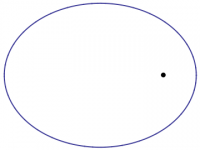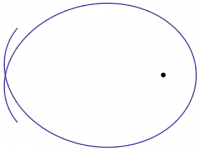Perihelion Shift of Mercury
Recall from previous sections that the timelike geodesics of the Schwarzschild geometry satisfy \begin{align} \dot\phi &= \frac{\ell}{r^2} \\ \dot{t} &= \frac{e}{\left(1-\frac{2m}{r}\right)} \\ \dot{r}^2 &= e^2 - \left( 1-\frac{2m}{r} \right) \left( 1+ \frac{\ell^2}{r^2} \right) \label{tgeo} \end{align} Setting \begin{equation} u = \frac{1}{r} \end{equation} we have \begin{equation} \dot{r} = -\frac{1}{u^2} \dot{u} = -r^2 \dot{u} = -\ell \> \frac{\dot{u}}{\dot\phi} = -\ell \> \frac{du}{d\phi} \end{equation} so that the last equation in ($\ref{tgeo}$) becomes \begin{align} \left( \frac{du}{d\phi} \right)^2 &= \frac{e^2}{\ell^2} - ( 1-{2m}{u} ) \left( \frac{1}{\ell^2} + u^2 \right) \nonumber\\ &= \frac{e^2-1}{\ell^2} + \frac{2mu}{\ell^2} - u^2 + 2mu^3 \label{tgeo2} \end{align} Differentiating ($\ref{tgeo2}$) with respect to $\phi$ results in \begin{equation} \frac{d^2 u}{d\phi^2} = \frac{m}{\ell^2} -u + 3mu^2 \label{tgeo3} \end{equation} which we rewrite in the form \begin{equation} \frac{d^2 (\ell u)}{d\phi^2} + \ell u = \frac{m}{\ell} + 3\,\frac{m}{\ell}\,(\ell u)^2 \label{tgeo4} \end{equation} The last term in ($\ref{tgeo4}$) is a relativistic correction to the corresponding Newtonian equation, and is small compared to the other terms for planetary motion.
Assuming $m^2\ll\ell^2$, we seek approximate solutions of ($\ref{tgeo3}$) of the form \begin{equation} u = \frac{m}{\ell} \left( u_0 + u_1 \frac{m^2}{\ell^2} \right) \label{uapprox} \end{equation} where we ignore higher powers of $\frac{m^2}{\ell^2}$. Substituting ($\ref{uapprox}$) into ($\ref{tgeo4}$) and collecting terms of the same order yields \begin{align} \frac{d^2 (\ell u_0)}{d\phi^2} + \ell u_0 &= 1 \\ \frac{d^2 (\ell u_1)}{d\phi^2} + \ell u_1 &= 3 (\ell u_0)^2 \end{align}
The solution of the first equation is the conic section \begin{equation} \ell u_0 = 1 + e\cos\phi \end{equation} with eccentricity $e$. Idealized Newtonian orbits are indeed ellipses, as shown in Figure 1; for planetary orbits, the Sun is at one of the foci of the ellipse, as shown. A particular solution of the second equation is given by \begin{equation} \ell u_1 = 3 \left( 1 + \frac{e^2}{2} + e\phi\sin\phi - \frac{e^2}{6}\cos(2\phi) \right) \label{pshifteq} \end{equation}
The physically interesting term in ($\ref{pshifteq}$) is the third, which continues to increase with each revolution. Ignoring the other corrections, we have \begin{align} u &\approx \frac{m}{\ell^2} \left( 1 + e \cos\phi + \frac{3em^2}{\ell^2} \phi \sin\phi \right) \nonumber\\ &\approx \frac{m}{\ell^2} \left( 1 + e \cos\left(\phi\left(1-\frac{3m^2}{\ell^2}\right)\right)\right) \end{align} Thus, the period is no longer $2\pi$, but rather \begin{equation} \frac{2\pi}{1-3\frac{m^2}{\ell^2}} \approx 2\pi \left(1+3\frac{m^2}{\ell^2}\right) \end{equation} The perihelion shift, shown schematically in Figure 2, is therefore given by \begin{equation} \delta\phi = 2\pi - 2\pi \left(1+3\frac{m^2}{\ell^2}\right) = 6\pi \frac{m^2}{\ell^2} = 6\pi \left( \frac{Gm}{c\ell} \right)^2 \label{pshift} \end{equation} in radians per orbit, where we have restored the Newtonian conversion factors in the last step.
To this accuracy, we can determine the angular momentum $\ell$ using the Newtonian orbit. The mass of the sun is \begin{equation} m = 1.9891 \times 10^{33} \hbox{g} \end{equation} and the angular momentum can be computed from the Newtonian formula \begin{equation} \ell^2 = G M a (1-e^2) \end{equation} where $a$ is the length of the semimajor axis of the elliptical orbit. Inserting astronomical data for the orbit of Mercury, namely \begin{align} a &= 57.9 \times 10^6 \hbox{km} \\ e &= 0.2056 \end{align} into ($\ref{pshift}$), and using the fact that the orbital period of Mercury is \begin{equation} T = 87.97 \hbox{days} \end{equation} one obtains a perihelion shift of \begin{equation} \frac{100 \hbox{years}}{T} \, \delta\phi = 42.98 \frac{\hbox{seconds of arc}}{\hbox{century}} \end{equation} Thus, the rate of precession of the perihelion of the orbit of Mercury is just under 43 seconds of arc per century — precisely the discrepancy between observation and the Newtonian computation.

